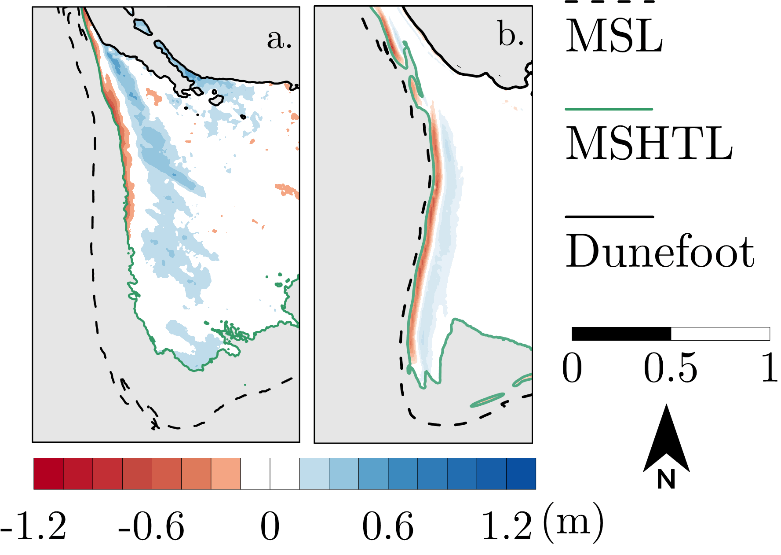F. Galiforni Silva1*, K. M. Wijnberg1, S. J. M. H. Hulscher1
1 University of Twente, This email address is being protected from spambots. You need JavaScript enabled to view it., This email address is being protected from spambots. You need JavaScript enabled to view it., This email address is being protected from spambots. You need JavaScript enabled to view it.
Introduction
Marine supply of sand can control the development and morphology of coastal dunes. However, processes that control the sediment transfer between sub-tidal and the supra-tidal zone are not fully understood, especially in coastal settings such as sand flats close to inlets. Wijnberg et. al. (2017) hypothesize that storm surge events may induce sediment deposition on sand flats, so that this may influence dune development. The objective of this study is to identify storm surge conditions on which deposition on sand flats occur and discuss the relation between the supra-tidal deposition and sediment supply to the dunes. To reach the goal, we use the sand flat called “De Hors”, in the island of Texel (NL), as a case study.
Methods
We use the numerical model XBeach to simulate 12 frequent storm conditions that reach the Texel inlet. For all scenarios, we used default values, followed by a validation check. From the simulations, we relate bed level change on the flat with local hydrodynamic characteristics (i.e. Hrms, u and v convergence, max water level) and general storm conditions, in order to check which processes would explain most of the bed level change and whether there is a relation between storm characteristics and storm-induced supra-tidal deposition.
Results and Discussion
Supra-tidal sand deposition occurred in 10 out of 12 scenarios, disposed most of the times in a clear shore-parallel north-south patch above mean spring high tide level (Figure 1). The deposited amount is correlated with storm energy, with stronger storms leading to more sedimentation onto the sand flat. Most deposition occurred at the beginning of the inundation phase, with most of the sediment being transported from regions below MSHTL and deposited above such elevation. This suggests that storm surges may act as a mechanism of sediment transfer between sub-tidal and sub-aerial zones on sand flats. Furthermore, prediction of the yearly amount of deposited sand based on water level data suggest that over time, the amount of sand deposited may be significant in terms of supply for dune growth, which is in agreement with Wijnberg et. al. (2017).

Figure 1: a. Elevation difference map from LiDAR data between 1998-1999. b. Example of elevation difference map from one simulation scenario.
References
Wijnberg, K. M., van der Spek, A. J., Galiforni Silva, F., Elias, E., van der Wegen, M., Slinger, J. H. (2017). Connecting subtidal and subaerial sand transport pathways in the Texel inlet system. In: Coastal Dynamics Proceedings, 235, p. 323-332.










